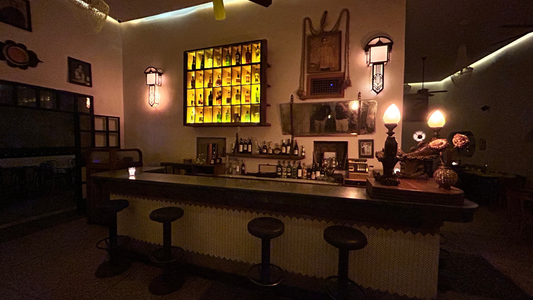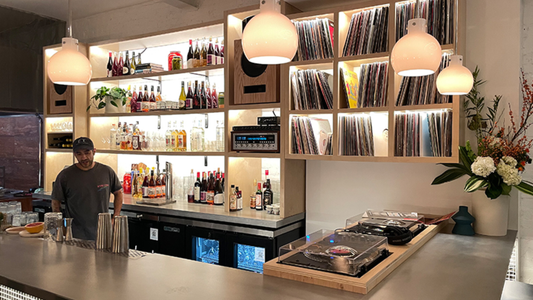
The First Global Guide to Listening Culture
How the slow act of listening is becoming the new language of luxury.
By Rafi Mercer
It began as a simple idea — a map of places where music still matters. Not the playlists or the algorithms, but the rooms, the people, the frequencies that hold human weight. A guide not to nightlife, but to listening itself.
That’s what Tracks & Tales was always meant to be: the first global guide to listening culture. A living atlas of the world’s most attentive spaces. But somewhere along the way, it became something larger — a movement, a conversation, a quiet rebellion against the noise.
Because what we’re documenting isn’t just bars and turntables. It’s a shift in human behaviour. The act of listening — once taken for granted, then lost to speed — is being rediscovered as a form of modern luxury.
I’ve watched it happen city by city.
In Tokyo, small basements where strangers sit in silence as Coltrane plays. In Lisbon, record cafés built like sanctuaries. In Los Angeles, new rooms where vinyl mixes with candlelight and old jazz finds new gravity. Even in London and Manchester, where sound once meant chaos, there are now havens for stillness. Everywhere, people are learning to listen again.
And what struck me most was the pattern. Wherever you find economic acceleration, digital saturation, or social fatigue — you also find these rooms. They emerge like a correction. They’re small, calm, serious about sound. A turntable sits where a screen used to be. The act of listening becomes not entertainment, but recovery.
That’s the pulse behind Tracks & Tales: a guide not just to where people go, but why they go there.
When I started writing these essays, I didn’t think of them as philosophy. But the more I travelled, the clearer it became that listening is not a pastime — it’s a worldview.
To listen is to slow down.
To slow down is to care.
And to care, in this era, is defiance.
Every city has its rhythm. But what defines our time is the loss of rhythm. We scroll, we skip, we skim. Music has become background to motion. Listening bars — and everything they represent — are the antidote. They are spaces of measured time, of human-scale presence.
That’s what the guide is trying to capture: the places where attention is design. Where the sound system isn’t an accessory but an ethic. Where conversation is optional, but silence is shared.
The project has grown faster than I imagined. What began as a notebook of venues has turned into a cultural architecture — essays, atlases, and daily dispatches that connect Tokyo to Toronto, Marrakesh to Manchester. But its foundation is still small. Each piece is a moment of listening, translated into story.
And through it all, the principle remains simple: listening culture is living culture.
When you map the world through sound, you start to see new geographies — not of nations, but of frequencies.
Tokyo and New York share more than design; they share reverence.
Lisbon and Seoul, both by the sea, share warmth in tone and pace.
Berlin and Detroit share rhythm — the industrial heartbeat beneath their art.
The guide isn’t a catalogue. It’s a network of feeling.
People often ask me why it matters — why listening deserves a global guide when the internet already gives us access to everything. My answer is always the same: access is not experience.
You can stream any record in the world, but you can’t stream atmosphere. You can’t stream the vibration of wood, the scent of whisky, the softness of low light. You can’t stream the silence between people who are listening together.
What we’re really mapping is humanity — the texture of attention in a distracted age.
That’s why it feels more like anthropology than journalism. Every venue tells you something about how its city thinks. Tokyo listens with precision; Berlin listens with endurance; London listens with irony and nostalgia; New York listens to move. These rooms are mirrors — social instruments measuring how we live, connect, and remember.
I’ve come to believe that listening is the last unexploited luxury. Not because it’s rare, but because it’s finite. True listening costs time, and time has become the world’s most valuable resource. That’s what Dre and Iovine understood with Beats, what D’Angelo practiced in his silences, what every small bar owner who aligns their speakers by hand knows instinctively: sound is value.
The global guide isn’t a product; it’s a philosophy in motion. It’s the architecture of care — a way to reconnect emotion to environment. When we publish a new city, it’s not about the number of venues. It’s about marking a place where the act of listening still has ritual.
What’s next is already beginning to take shape.
A Michelin-style index for sound — one, two, three stars not for food, but for fidelity, feeling, and flow. A way to measure cultural resonance, not calories. It’s a guide that rewards presence. A future where people plan trips not around sightseeing, but soundseeing — choosing cities for how they listen.
And that’s the quiet revolution hidden inside this project: it’s teaching people to travel differently. To choose depth over breadth, patience over pace. To understand that music is not escape, but entry — a way into the emotional architecture of a place.
When I look ahead, I see Tracks & Tales less as a media platform and more as a movement of sensibilities. A bridge between sound, style, and stillness. Between how we dress, how we drink, and how we hear. Every essay, every venue, every photo is another brick in a new cultural house — one built for resonance.
And like all true houses, it will never really be finished.
That’s the beauty of listening: it keeps becoming.
Because the world keeps changing, and we keep tuning to it — city by city, bar by bar, heartbeat by heartbeat.
We’re building the world’s first guide to listening culture not to define it, but to hold it — to give shape to a feeling that’s already in the air.
Listening is design.
Success is resonance.
Defiance is stillness.
Curation is care.
Optimism is attention.
That’s what this guide is about. And that’s what it means to live — and listen — in our time.
Quick Questions
What is the Global Guide to Listening Culture?
A living atlas of venues, stories, and essays documenting how the world is rediscovering the art of listening — city by city, sound by sound.
Why does it matter?
Because in a distracted age, attention itself has become a luxury. The guide celebrates places and people who preserve it.
Where is it going next?
Everywhere that sound still has soul — Tokyo, Marrakesh, Nashville, Lisbon, Seoul, and beyond. The map keeps growing.
Rafi Mercer writes about the spaces where music matters.
For more stories from Tracks & Tales, subscribe, or click here to read more.







